 |
 |
Common Fish & Crustaceans of the Caribbean that are regularly spotted around Roatan
 |
 |
| Angelfish Pomacanthidae |
Blue, Gray, French, Queen Angelfish | ||
| Barracuda Sphyraena picudilla |
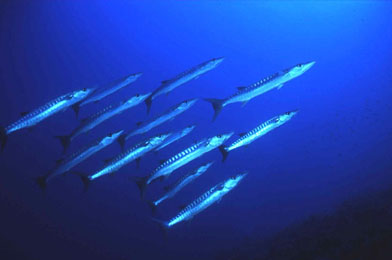 |
Features: Large underslung jaw with
obvious, pointed teeth on silver body. Widely separated
dorsal fins. Either solitary or in small groups, Barracuda frequently approach divers and follow them around the reef, as if they were curious. There have never been documented attacks on divers. |
|
| Black
durgon Melichthys niger |
Features: Black body, pale blue
lines along base of dorsal and anal fins. Similar in
shape to Triggerfish. Can have blue with yellow accents
around head. Can grow to 16". Very shy, will hide in coral holes and lock themselves in plave by raising their dorsal spine. Tend to live below 20'. |
||
| Blennies/Gobies Gobiidae, Clinidae, Tripterygiidae, Blennidae |
All are small (under 3"), elongated fish with
cylindrical bodies which inhabit the bottom or make small
burrows. Over 50 distinct species. Several species are
cleaner fish. Gobies have two dorsal fins, while Blennies have one, long continous fin. |
||
| Blue
chromis Chromis cyanea |
 |
Features: Deeply forked tails with
dark borders. Swim in large groups feeding on plankton, mixed with Brown Chromis and Damselfish (which are the same family) |
|
| Blue
runner Caranx crysos |
Features: Silvery, with black spot
at top of gills. Tips of tail fins are dark. Member of
the Jack family, with forked tail and sloping head. Travel in large schools in offshore waters. |
||
| Blue Tang Acanthurus coeruleus |
Features: Blue body, white or yellow
spine on base of tail. Thin body, oval profile. Can be solitary on shallow reeftops, but frequently in large schools, which will often include Surgeonfish and Doctorfish.Tend to ignore divers, but will move away when approached. |
||
| Butterflyfish Chaetondontidae
|
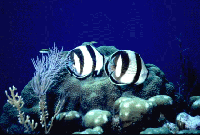 |
Features: Two wide, black mid-body
bars. Silver to white body. Black bar runs through eye.
Juveniles have eye spot near tail. Thin body, oval
profile. Flits about reef tops, often in pairs. Tend to ignore divers, but will move away when approached. |
|
| French
angelfish Pomacanthus paru (Gray Angelfish |
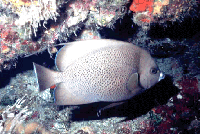 |
Features: Black with bright yellow
rims on scales, rounded tail. All fins are black except
for yellow spot on pectoral fin. Thin body, oval profile. Unafraid of divers, easy to approach. Frequently found in pairs. |
|
| Tiger
Grouper Mycteroperca tigris |
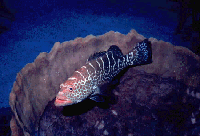 |
Features: White tiger-stripes. Can
change colors. Solitary on reef walls and bottoms. Can be found frequently in cleaning stations. Other Groupers: Jewfish, Nassau, Red, Yellowfin, Black, Yellowmouth, Comb, Marbled & (Red) Hinds, Greysbys,Coneys. |
|
| Grunts Pomadasyidae |
Bluestriped, Spanish, Smallmouth, Striped, White,
Caesar. Cottonwick, French Features: Grunts come in many sides and are abundant throughout the Caribbean. Most have multiple horizontal stripes on face and body. "V" shaped tail, sloping head & tapered body. Frequently travel in groups. Differnent varieties prefer different depths. |
||
| Harlequin
bass Serranus tigrinus |
Features: Dark bars on white upper
body with yellow underbelly. Several dark spots form
horizontal lines running length of body. Head is pointed,
tail is flat with spots. Under 4 inches. Drifts above bottom and in sea grass, feeds on small crustaceans. |
||
| Horse-eye jack Caranx latus |
Features: Silver body like all
jacks, with yellow tail fins and clear pectoral fin. Swim in open water in schools, sometimes mixed with other jacks, such as Crevalle. |
||
| Jewfish Epinephelus itajara |
Features: member of the grouper
family, they have large, heavy bodies with large lips.
Splotchy, dark spots all over bodies. Can grow up to 8
ft. long. Reclusive, found in caves and wrecks. |
||
| Lobster |  |
||
| Manta ray Manta birostris |
 |
Features: Large mouth with feeding
'scoops' at leadin edge of head. Dark back with white
underside. Very uncommon, plankton feeder generally ignores divers unless closely approached. Can be distinguished from Devil Rays, who have mouth on bottom of body like stingrays. |
|
| Parrotfish Scaridae |
Queen, Rainbow, Princess, Blue, Striped, Midnight,
Stoplight, Redband, Tellowtail, Greenblotch. Parrot fish are distinctive because of their brilliant colors, an their swimming style, using only their pectoral fins, giving them the illusion of 'flying' through the water. All posess long bodies and powerful jaws that look like beaks which they use to scrape the coral. Colors vary greatly from Juvenile to Adult, and many female adults switch sex to become 'Supermales.' |
||
| Permit Trachinotus falcatus |
Features: High head-back profile,
two-part dorsal fin, tall and pointed in front, low in
back, silver body and thin, deeply forked tails. A member of the Jack family (Crevalle, Horse-eye), they are deep sea predators, schools will sometimes approach reefs to feed on small fish. |
||
| Porcupinefish Diodon hystrix |
Features: Small spots on fins and
spots on fins. No spines on head like Burrfish and
baloonfish. Shy, hide in coral holes & cave openings. |
||
| Southern Sting Ray Dasyatis americana |
 |
Features: Southern Stingrays have
pointed noses and pointed wing-tips. Varied colors, dark
on top, white bottoms. Thin tail with poisonous spines at
base. Can be approached on sandy bottoms. |
|
| Sargent
Majors Abudefduf saxatilis |
Features: Five black bars, with
yellow spots on silver-blue bodies. 'Small' fish (under
3"), with oval bodies. Unafraid of divers. Territorial, will defend coral 'nests'. Member of Damselfish family. |
||
| Sea
Horses Hippocampus erectus |
Features: Not common. You'll know it when you see it. Allow divers to approach closely. Territorially grasp branches of seafans or grasses with their tails. |
||
| Sharks; Nurse, Sand, Reef, Whale | 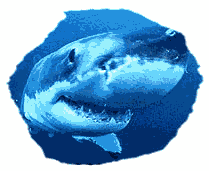 |
||
| Nurse Shark Ginglymostoma cirratum |
Features: Two barbs on the mouth,
two dorsal fins, elongated streight tail and a small
mouth distinguish the nurse shark. Can be approached closely as they lie motionless on the ground. Lie on the sand, under coral ledges and overhangs. |
||
| Shrimps | |||
| Silversides Atherinidae |
Features: Tiny, silver, forked
tailed, schooling fish. Along with Anchovies, Herring & Scad, there are 10 different species which are virtually impossible to distinguish. Travel in large schools that are dense and 'polarized'. Will part and flow around divers and predators. |
||
| Atlantic Spadefish Chaetodipterus faber |
Features: Oval, flat body under 2 ft
long with high sloping head, and prominent dorsal and
anal fins. Several dark bars color a silver body. Body
shape resembles a playing card 'spade'. Swim in schools in open water. Sometimes approach divers, attracted by the bubbles. |
||
| Spider crab | |||
| Spotted
eagle rays Aetobatus narinari |
Features: Pointed head, tapered
snout, white underside, long tail with venomous spine(s)
at base. Very shy, will leave area soon after spotting divers. Feed on mollusks on sandy bottoms. |
||
| Triggerfish Balistidae |
Features: Front dorsal spine which
can be raised or lowered, and locked into place with a
second spine, called a 'trigger'. Shaped like a flattened
football, with a large anal fin. Swims using both dorsal
and anal fins in fanning motion. Rarely seen in schools. Queen, Gray, Ocean and Sargassum species. |
||
| Trunkfish Lactophyrys triqueter |
Features: Dark body covered with
white spots. Differentiated from other Boxfish by lack of
spine over each eye. Normally solitary, unafraid of divers. An awkward swimmer. |
||
| Turtles (Hawksbill) | |||
| Whale
Sharks Rhincodon typus |
 |
Whale Sharks were spotted at the mouth of French Harbor on Roatan at the middle of February this year. | |
| Wrasses Labridae |
Creole, Puddingwife, Yellowhead, Cleaner, Slippery
Dick, Yellowcheek, Bluehead, Clown, Dwarf. All have buck teeth that protrude, and come in diverse colors. Long bodies, similar to their close relations, the Parrotfish. Also change sex at adulthood. Wrasse frequently 'staff' cleaning stations and remove parasites and dead scales from larger fish at 'cleaning stations'. |
||
| Yellow
Snapper Ocyurus chrysurus |
Features: Brilliant yellow body
stripe and tail. Silver to white body with blue tinge.
Deeply forked tail. Sloping head. Swim alone or small schools above reefs. Unafraid of divers and will approach closely. |
||
| Active Night Fish: | |||
| Basket star | |||
| Bigeyes Apogonidae, Holocentrdae & Priacanthidae |
Cardinalfish, squirrelfish, Glasseye Snapper,
Soldierfish, Bigeye. Noctural feeders. Distinctive big eyes. Range of colors. Generally small size. |
||
| Brittle star | |||
| Eel, Green Moray, Spotted Moray Gymnothorax funebris, moringa |
Features: Green Moray (funebris) &
Spotted Moray (moringa) are most common.
Purplemouth Moray, Goldentail Moray & Chain Moray are
rarer. Rarely found swimming free, normally only heads protrude from holes in coral. Generally nocturnal feeders. |
||
| Flounder Bothidae |
Features: Eyes on top side of body.
Lie on their side, partially buried in sand. Can be closely approached as they rely on careful camoflage. Move only when diver gets too close. |
||
| Octopus | |||
| Spider Crab |
ęDrew Thompson 1999
All Rights Reserved
All images and gifs are in the public domain.
Some pictures taken by the author.